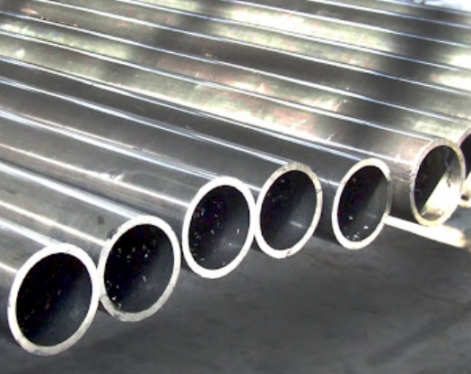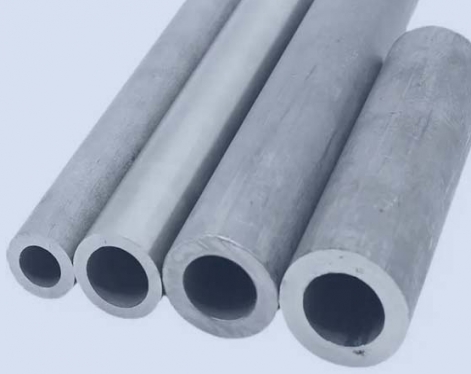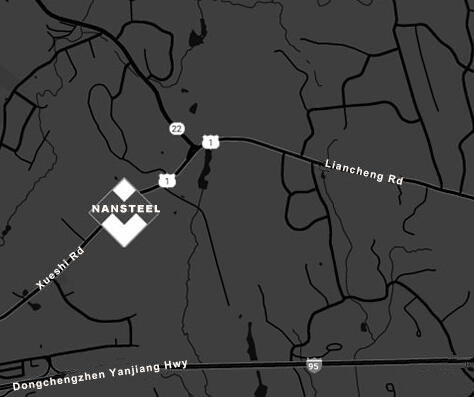The wall thickness of seamless steel pipe has an important influence on its performance, especially in terms of strength, pressure bearing capacity, corrosion resistance, processing performance, etc. Nansteel Manufacturing Co., Ltd carefully summarizes the following main effects of seamless steel pipe wall thickness on performance:
Thicker wall thickness provides greater strength and pressure-bearing capacity: For applications subject to high pressure, thicker wall thickness provides greater mechanical strength and pressure-bearing capacity. Thicker steel pipes are able to withstand higher internal pressures or external loads, reducing the risk of rupture.
The thinner the wall thickness, the lower the pressure bearing capacity and deformation resistance: thinner steel pipes are prone to plastic deformation or rupture under high pressure environments.
Wall thickness has an indirect effect on corrosion resistance: Although the corrosion resistance of steel pipes is mainly related to the material and surface treatment, thicker wall thickness can provide longer service life when corrosion occurs on the inner and outer surfaces of the pipe. Thick-walled pipes can retain the ability to operate safely for a longer period of time when the corrosion layer is lost.
Thin-walled steel pipes are susceptible to corrosion: Thin-walled steel pipes may easily penetrate or lose structural strength after surface corrosion, especially when used in corrosive environments.
Thicker steel pipes have better resistance to deformation: Under high temperature or thermal expansion conditions, thicker steel pipes can better resist thermal expansion and deformation caused by temperature changes. In high temperature environments, thin-walled steel pipes are prone to deformation due to thermal expansion, causing pipe rupture or failure.
Thin-walled pipes are more likely to deform: When subjected to external forces or temperature changes, thin-walled seamless steel pipes are more likely to bend, twist or expand.

4. Machinability
Thick-walled steel pipes are more difficult to process: thicker steel pipes may require higher power, more processing time and cost when processing and welding. Heat treatment problems of materials (such as thermal expansion, uneven hardness, etc.) are more likely to occur during processing.
Thin-walled steel pipes are easier to process: Thin-walled steel pipes are relatively easy to process, and the difficulty of processing techniques such as cutting, bending, and welding is relatively low. Therefore, thin-walled steel pipes may be more suitable for some products that require large-scale production or shorter delivery times.
5. Weight and Transportation
The greater the wall thickness, the greater the weight of the steel pipe: Thicker steel pipes weigh more, which not only increases transportation costs, but may also require stronger support structures to hold the pipes in place. For projects that require long-distance transportation and installation, thicker pipes may require more resources and costs to transport.
Thin-walled steel pipes are lighter and have lower transportation and installation costs: Thin-walled steel pipes are lighter in weight and are suitable for large-scale pipeline projects, especially when lower pipeline strength requirements are required.
6. Cost
Thick-walled steel pipes are more expensive: Due to the material consumption and processing difficulty in the production process, the cost of thick-walled seamless steel pipes is relatively high. When producing thick-walled steel pipes, more raw materials are required, and the processes such as heating, stretching and processing are also more complicated.
Thin-walled steel pipes are more cost-effective: Thin-walled steel pipes use less raw materials and are simpler to produce and process, so their cost is lower.
7. Fluid transport capacity
When the wall thickness is large, the inner diameter is relatively small: For seamless steel pipes with the same outer diameter, the greater the wall thickness, the smaller the inner diameter of the pipe. This will lead to a decrease in the fluid transport capacity, so in applications with large fluid transport volumes, thinner steel pipes are usually selected.
When the wall thickness is thin, the inner diameter is relatively large: thinner wall thickness can provide a larger inner diameter, thereby increasing the fluid transport capacity. Therefore, for occasions with high fluid transport capacity requirements, it is very important to choose the appropriate wall thickness.
8. Wear resistance
Thick-walled steel pipes have strong wear resistance: For some steel pipes working in high-wear environments (such as steel pipes in mines and conveying systems, etc.), thicker steel pipes can usually provide longer service life and better wear resistance.
Thin-walled steel pipes have weak wear resistance: Due to their thin thickness, thin-walled steel pipes are easily damaged in high-wear environments, so they are generally not suitable for high-wear occasions.
Conclusion
The wall thickness of seamless steel pipe has many effects on its performance. The key factors include:
Strength and pressure bearing capacity: Thick-walled steel pipes can withstand greater pressure and have stronger resistance to rupture.
Corrosion resistance: Thick-walled steel pipes have stronger corrosion resistance.
Processing and transportation costs: Thin-walled steel pipes have lower processing and transportation costs, but their bearing capacity is relatively weaker.
Wear resistance and deformation: Thick-walled steel pipes have better wear resistance and deformation resistance.
When choosing seamless steel pipes, it is necessary to reasonably select the wall thickness based on the specific application environment, pressure requirements, fluid transportation needs and cost budget. If the pipeline is subjected to higher pressure or needs to withstand greater external forces, thicker seamless steel pipes are usually selected; for low-pressure, high-flow applications, thin-walled steel pipes may be more suitable.
Read more : The Advantages of Seamless Steel Pipes in the Power Industry
1. Strength and pressure bearing capacity
Thicker wall thickness provides greater strength and pressure-bearing capacity: For applications subject to high pressure, thicker wall thickness provides greater mechanical strength and pressure-bearing capacity. Thicker steel pipes are able to withstand higher internal pressures or external loads, reducing the risk of rupture.
The thinner the wall thickness, the lower the pressure bearing capacity and deformation resistance: thinner steel pipes are prone to plastic deformation or rupture under high pressure environments.
2. Corrosion resistance
Wall thickness has an indirect effect on corrosion resistance: Although the corrosion resistance of steel pipes is mainly related to the material and surface treatment, thicker wall thickness can provide longer service life when corrosion occurs on the inner and outer surfaces of the pipe. Thick-walled pipes can retain the ability to operate safely for a longer period of time when the corrosion layer is lost.
Thin-walled steel pipes are susceptible to corrosion: Thin-walled steel pipes may easily penetrate or lose structural strength after surface corrosion, especially when used in corrosive environments.
3. Thermal expansion and deformation
Thicker steel pipes have better resistance to deformation: Under high temperature or thermal expansion conditions, thicker steel pipes can better resist thermal expansion and deformation caused by temperature changes. In high temperature environments, thin-walled steel pipes are prone to deformation due to thermal expansion, causing pipe rupture or failure.
Thin-walled pipes are more likely to deform: When subjected to external forces or temperature changes, thin-walled seamless steel pipes are more likely to bend, twist or expand.

4. Machinability
Thick-walled steel pipes are more difficult to process: thicker steel pipes may require higher power, more processing time and cost when processing and welding. Heat treatment problems of materials (such as thermal expansion, uneven hardness, etc.) are more likely to occur during processing.
Thin-walled steel pipes are easier to process: Thin-walled steel pipes are relatively easy to process, and the difficulty of processing techniques such as cutting, bending, and welding is relatively low. Therefore, thin-walled steel pipes may be more suitable for some products that require large-scale production or shorter delivery times.
5. Weight and Transportation
The greater the wall thickness, the greater the weight of the steel pipe: Thicker steel pipes weigh more, which not only increases transportation costs, but may also require stronger support structures to hold the pipes in place. For projects that require long-distance transportation and installation, thicker pipes may require more resources and costs to transport.
Thin-walled steel pipes are lighter and have lower transportation and installation costs: Thin-walled steel pipes are lighter in weight and are suitable for large-scale pipeline projects, especially when lower pipeline strength requirements are required.
6. Cost
Thick-walled steel pipes are more expensive: Due to the material consumption and processing difficulty in the production process, the cost of thick-walled seamless steel pipes is relatively high. When producing thick-walled steel pipes, more raw materials are required, and the processes such as heating, stretching and processing are also more complicated.
Thin-walled steel pipes are more cost-effective: Thin-walled steel pipes use less raw materials and are simpler to produce and process, so their cost is lower.
7. Fluid transport capacity
When the wall thickness is large, the inner diameter is relatively small: For seamless steel pipes with the same outer diameter, the greater the wall thickness, the smaller the inner diameter of the pipe. This will lead to a decrease in the fluid transport capacity, so in applications with large fluid transport volumes, thinner steel pipes are usually selected.
When the wall thickness is thin, the inner diameter is relatively large: thinner wall thickness can provide a larger inner diameter, thereby increasing the fluid transport capacity. Therefore, for occasions with high fluid transport capacity requirements, it is very important to choose the appropriate wall thickness.
8. Wear resistance
Thick-walled steel pipes have strong wear resistance: For some steel pipes working in high-wear environments (such as steel pipes in mines and conveying systems, etc.), thicker steel pipes can usually provide longer service life and better wear resistance.
Thin-walled steel pipes have weak wear resistance: Due to their thin thickness, thin-walled steel pipes are easily damaged in high-wear environments, so they are generally not suitable for high-wear occasions.
Conclusion
The wall thickness of seamless steel pipe has many effects on its performance. The key factors include:
Strength and pressure bearing capacity: Thick-walled steel pipes can withstand greater pressure and have stronger resistance to rupture.
Corrosion resistance: Thick-walled steel pipes have stronger corrosion resistance.
Processing and transportation costs: Thin-walled steel pipes have lower processing and transportation costs, but their bearing capacity is relatively weaker.
Wear resistance and deformation: Thick-walled steel pipes have better wear resistance and deformation resistance.
When choosing seamless steel pipes, it is necessary to reasonably select the wall thickness based on the specific application environment, pressure requirements, fluid transportation needs and cost budget. If the pipeline is subjected to higher pressure or needs to withstand greater external forces, thicker seamless steel pipes are usually selected; for low-pressure, high-flow applications, thin-walled steel pipes may be more suitable.
Read more : The Advantages of Seamless Steel Pipes in the Power Industry









